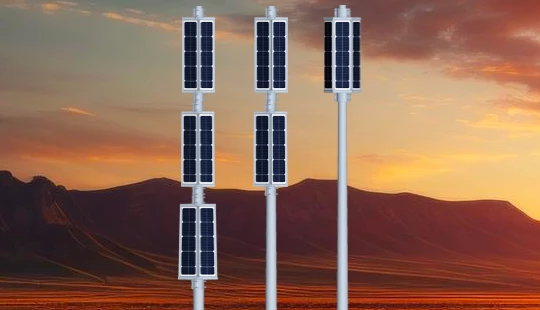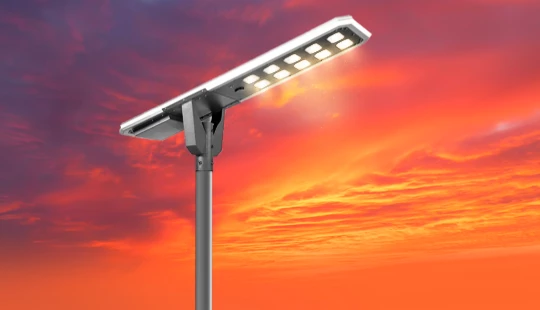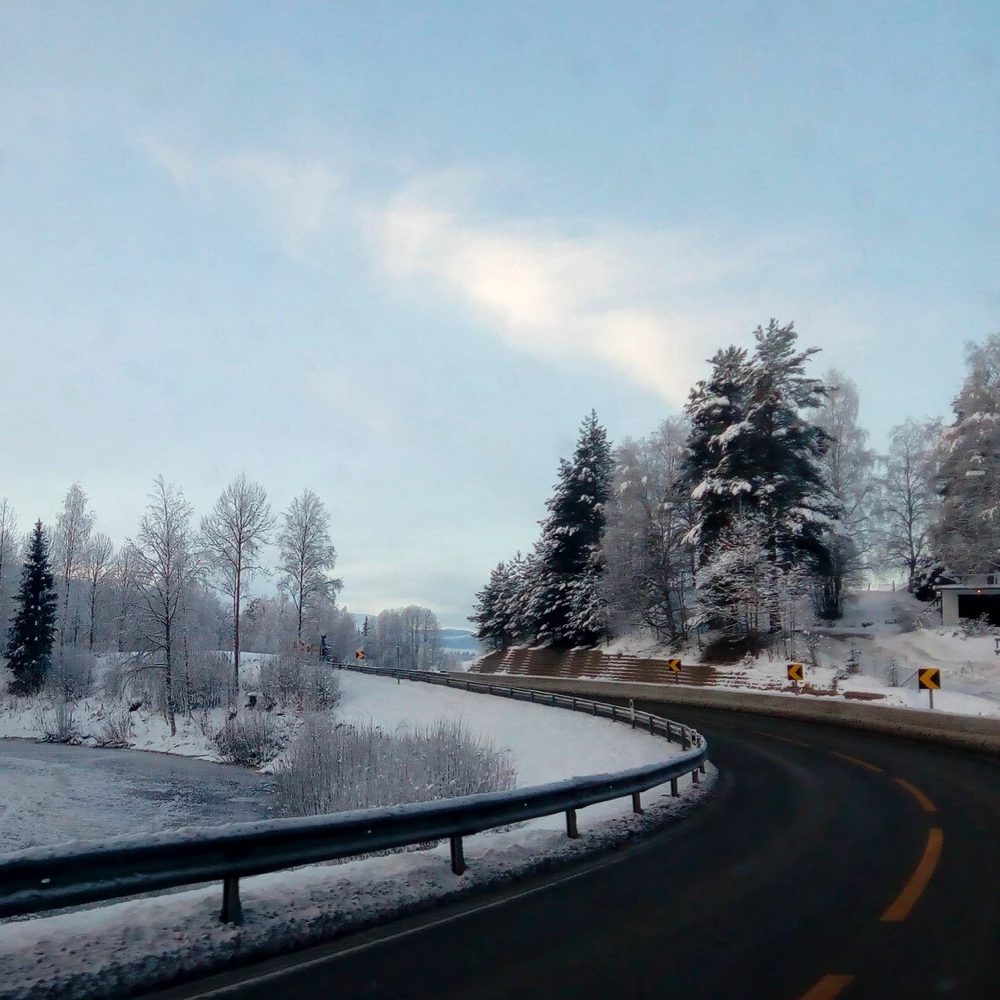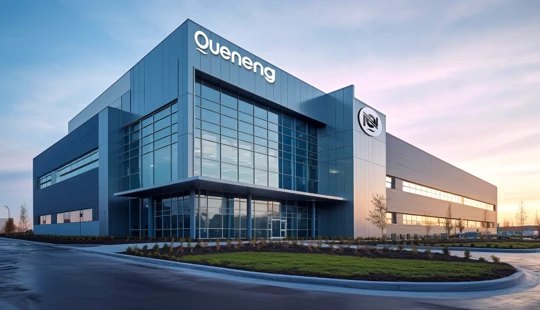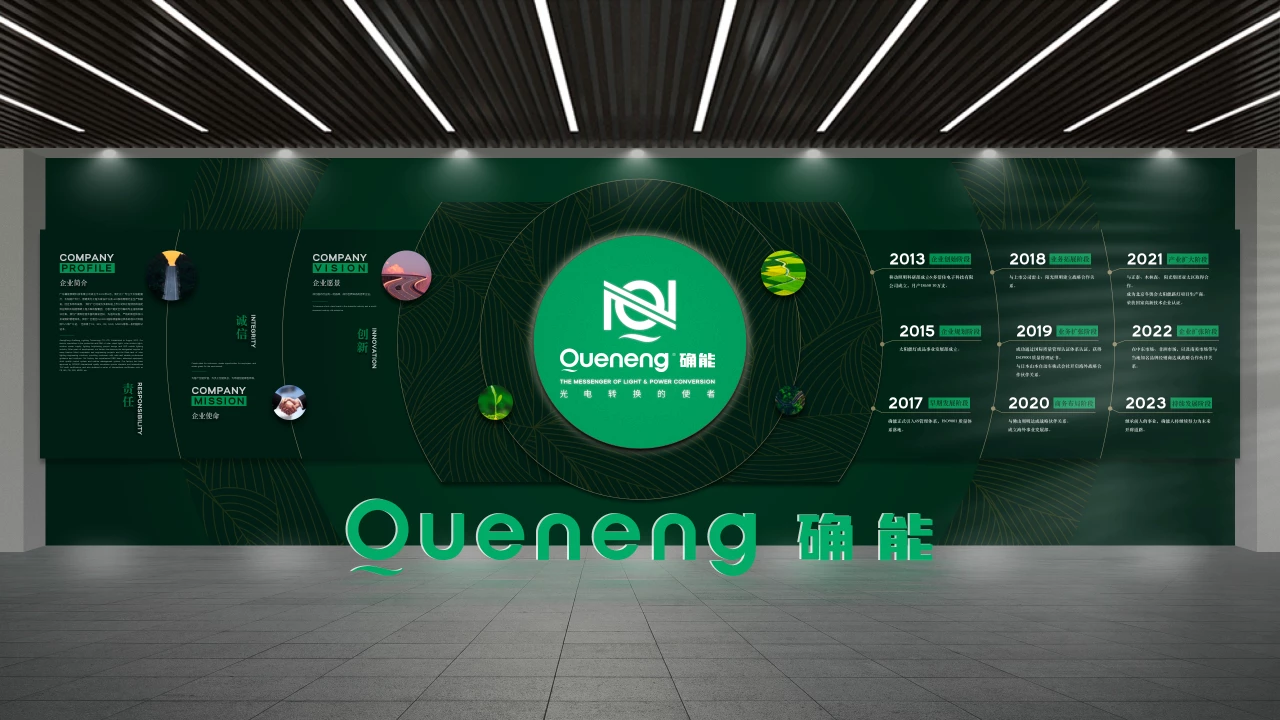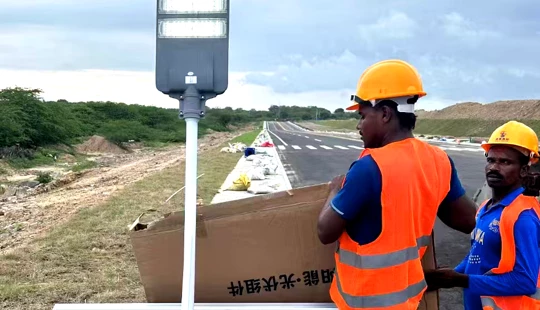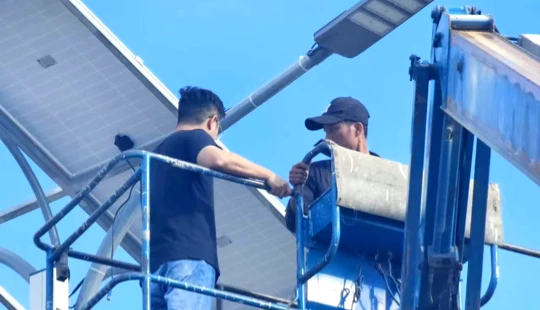Custom how to request custom solar street lights from manufacturers Manufacturers and Suppliers
As a professional content writer with extensive SEO experience and a deep understanding of the solar lighting industry, I'm here to guide you through the intricate process of acquiring bespoke solar street lighting solutions.
In an era where sustainability meets innovation, solar street lights have emerged as a beacon of eco-friendly and cost-effective illumination. While off-the-shelf solutions serve many purposes, specific projects often demand tailored approaches. This is where the expertise of manufacturers specializing in custom solar street lights becomes indispensable. For businesses, municipalities, and developers looking to implement unique or large-scale lighting projects, understanding how to request custom solar street lights from manufacturers effectively is key to success.
Understanding the Growing Need for Custom Solar Street Lights
The demand for solar street lighting is skyrocketing, driven by a global push for sustainable infrastructure and energy independence. The global solar street lighting market was valued at approximately USD 7.2 billion in 2022 and is projected to reach over USD 25 billion by 2032, exhibiting a compound annual growth rate (CAGR) of around 13% to 14%. This impressive growth is fueled by government initiatives, decreasing component costs, and the undeniable benefits of solar power. Within this expansion, the need for custom solutions is becoming increasingly prominent.
Unlike standard products, custom solar street lights are designed to meet precise project requirements, addressing specific environmental conditions, aesthetic considerations, and performance criteria. Whether it's a unique architectural project, an off-grid remote location with extreme weather, or a large-scale urban development demanding specific light distribution, a custom approach ensures optimal performance and seamless integration. For example, a standard 60W solar street light might be adequate for a residential street, but a busy highway intersection in a low-sunlight region will require a bespoke system with a larger solar panel, higher capacity battery, and specialized optics to ensure consistent illumination and safety.
Why Partnering with the Right Manufacturer is Crucial for Custom Projects
When embarking on a custom solar street light project, the choice of manufacturer is paramount. A proficient manufacturer doesn't just produce lights; they act as a comprehensive solutions provider and an engineering think tank. For example, GuangDong Queneng Lighting Technology Co., Ltd., founded in 2013, has established itself as a leader in this field. Our focus extends beyond manufacturing to include lighting project design and providing safe and reliable professional guidance. Our long-standing partnerships with numerous famous listed companies and engineering projects testify to our capability as a designated supplier of custom solar lighting solutions.
Choosing a manufacturer with a robust R&D team, advanced equipment, and stringent quality control systems is non-negotiable. This ensures that your custom solar street lights are not only designed to perfection but also manufactured to the highest standards. Certifications like ISO 9001 international quality assurance system, TÜV audit, and product-specific approvals (CE, UL, BIS, CB, SGS, MSDS) provide tangible proof of a manufacturer's commitment to quality and reliability. Such credentials mean your custom solar lighting solutions will be durable, efficient, and compliant with international standards.
The Step-by-Step Process: How to Request Custom Solar Street Lights from Manufacturers
Requesting custom solar street lights is a collaborative journey that requires clear communication and detailed planning. Here’s a step-by-step guide to navigate the process with a professional solar lighting manufacturer.
Step 1: Define Your Project Requirements Clearly
The foundation of any successful custom project lies in a clear understanding of your needs. Before approaching custom solar street light manufacturers, articulate your project's specifics. Consider:
- Location: Geographical coordinates, average daily solar insolation (e.g., a site in Arizona might receive 6 kWh/m²/day, while one in Northern Europe might receive 2 kWh/m²/day), local climate conditions (temperature extremes, humidity, wind speeds, snow load).
- Application: Road lighting, pathway, parking lot, garden, industrial area, public park, etc. Each application has different lighting requirements and safety standards.
- Lighting Needs: Required lumen output (brightness), light distribution pattern (Type II for roads, Type V for large areas), color temperature (CCT, e.g., 3000K warm white for aesthetic areas, 5000K-6000K cool white for general illumination), hours of operation (e.g., dusk-to-dawn, split-hour operation, motion-sensing).
- Pole Height and Spacing: These dictate the light coverage and intensity needed from each fixture.
- Aesthetics: Desired design, color, and finish of the pole and fixture to match the surrounding environment.
- Budget: A realistic budget range helps the manufacturer propose suitable solutions without overdesigning or underdelivering.
Step 2: Prepare Essential Project Documentation
To facilitate the design process, gather any relevant documents that can provide context to your project. This might include:
- Site plans or maps indicating pole locations, dimensions, and obstacles.
- Existing lighting layouts (if upgrading).
- Photographs of the site.
- Any specific local regulations or standards for lighting and installation.
- Desired control features (e.g., smart controls, dimming, motion sensors, remote monitoring capabilities).
Step 3: Initiate Contact and Share Your Vision
Once you have a clear picture of your requirements, reach out to your chosen solar street light manufacturers. A formal Request for Information (RFI) or an initial consultation call is a good starting point. Be prepared to share all the details gathered in Steps 1 and 2. The more comprehensive your initial brief, the more accurate and relevant the manufacturer's preliminary proposals will be. This is where Queneng's solutions think tank approach comes into play, as our experts begin to conceptualize the optimal system.
Step 4: Collaborate on Design and Technical Specifications
This is a critical phase where the manufacturer's R&D team collaborates closely with you. Leveraging advanced software, the team will:
- Perform Photometric Studies: Simulate light distribution to ensure optimal coverage and uniformity, meeting specific lux level requirements (e.g., 20 lux for major roads, 5 lux for pathways).
- Energy Calculations: Determine the appropriate size for the solar panel and battery based on solar insolation data, desired autonomy (days of backup power without sunlight, typically 3-5 days), and daily energy consumption.
- Solar Panel Technology: Modern monocrystalline solar panels typically achieve efficiencies of 20-23%, while advanced PERC or TOPCon cells can exceed 24%, maximizing energy capture in smaller footprints.
- Battery Technology: Lithium Iron Phosphate (LiFePO4) batteries are preferred for their long life (2,000-5,000 charge cycles, lasting 5-10 years) and safety, significantly outperforming traditional lead-acid batteries.
- Component Selection: Specify LED chips (e.g., Lumileds, Cree) for high luminous efficacy (150-200 lumens per watt), smart controllers (MPPT for maximum power harvest, dimming functions, timers), and robust housing materials.
- Structural Design: Engineer the pole and fixture to withstand environmental factors like wind loads (e.g., 120-160 km/h wind resistance) and seismic activity.
Multiple iterations of the design may be necessary until all parties are satisfied with the proposed custom solar lighting solution. This iterative process ensures the final design is perfectly aligned with your functional and aesthetic expectations.
Step 5: Review Proposals and Samples
After the design is finalized, the manufacturer will provide a detailed proposal, including technical specifications, pricing, lead times for production, and warranty information. It's crucial to review every aspect carefully. If feasible, request samples of key components or even a prototype of the custom solar street light. Seeing and testing a physical sample can provide invaluable insights and confirm that the design translates effectively into a tangible product. Pay close attention to warranty terms, which typically range from 3 to 5 years for the entire system and often longer for individual components like LEDs (up to 10 years).
Step 6: Manufacturing, Quality Control, and Delivery
Once the proposal is approved, manufacturing begins. This phase is where a manufacturer’s stringent quality control systems truly shine. At Queneng, our production is backed by ISO 9001, TÜV audit certification, and other international certificates like CE, UL, BIS, CB, SGS, and MSDS. This means every component, from the solar panel to the battery and the LED fixture, undergoes rigorous testing to ensure it meets performance and safety standards. Regular updates on production progress and adherence to agreed-upon timelines are essential. Upon completion, the custom solar street lights are securely packed for shipment to your project site.
Step 7: Installation and After-Sales Support
Even after delivery, the manufacturer's support is vital. A reputable manufacturer will provide comprehensive installation guidelines, and in some cases, offer technical support during the installation phase. Long-term after-sales service, including troubleshooting, maintenance advice, and warranty claims, ensures the longevity and continued optimal performance of your custom solar street lights. This ongoing partnership underscores the value of choosing a manufacturer committed to customer success.
The Queneng Advantage: Your Trusted Partner in Custom Solar Lighting
At GuangDong Queneng Lighting Technology Co., Ltd., we pride ourselves on being more than just a manufacturer; we are your dedicated solar lighting engineering solutions think tank. Our decade-long experience since 2013, combined with an experienced R&D team, advanced production equipment, and a rigorous quality control system, positions us perfectly to handle even the most complex custom solar street light projects.
We understand that custom solutions require precision, expertise, and reliability. From initial concept to final deployment, Queneng provides safe and reliable professional guidance and solutions, ensuring that your custom solar street lights not only meet but exceed your expectations. Our certifications and track record as a designated supplier for major projects reflect our commitment to excellence and our ability to deliver bespoke, high-performance solar lighting systems.
ConclusionRequesting custom solar street lights from manufacturers is a strategic investment that yields tailored, high-performance, and sustainable lighting solutions. By following a structured approach – from clearly defining your needs and collaborating on design to partnering with a reputable and certified manufacturer like GuangDong Queneng Lighting Technology Co., Ltd. – you can ensure your project's success. Our expertise, advanced capabilities, and unwavering commitment to quality make us the ideal partner for your next custom solar lighting endeavor, illuminating your vision with precision and reliability.
FAQs
Q1: What are the primary benefits of opting for custom solar street lights over standard ones?A1: Custom solar street lights offer tailored performance (optimized lumen output, battery autonomy), specific aesthetic integration, suitability for unique environmental conditions (extreme temperatures, high wind loads), and compliance with specific project or local regulations, ensuring optimal efficiency and longevity where standard products might fall short.
Q2: How long does it typically take to design and manufacture custom solar street lights?A2: The timeline varies significantly based on project complexity, order volume, and manufacturer's capacity. Design and prototyping can take 2-6 weeks, while manufacturing can range from 4-12 weeks. Large-scale or highly complex custom projects may require longer. It's crucial to discuss lead times upfront with your chosen manufacturer.
Q3: What information should I prepare before contacting a solar street light manufacturer for a custom project?A3: You should prepare detailed information about the project location (coordinates, climate data), desired lighting levels (lux, lumens), hours of operation, pole height and spacing, aesthetic preferences, specific control features (dimming, motion sensors), and a realistic budget. Site plans or diagrams are also highly beneficial.
Q4: Are custom solar street lights more expensive than standard models?A4: Generally, custom solar street lights have a higher initial cost due to specialized design, engineering, and smaller production runs. However, the long-term benefits of optimized performance, energy efficiency, reduced maintenance, and perfect fit for unique applications often result in a lower total cost of ownership (TCO) and a better return on investment (ROI) over the system's lifespan.
Q5: What kind of warranty and after-sales support can I expect for custom solar street lights?A5: Reputable manufacturers like Queneng typically offer comprehensive warranties, usually 3-5 years for the complete system, and longer for specific components like LEDs (5-10 years) and batteries (3-7 years). After-sales support includes technical assistance, troubleshooting, spare parts availability, and sometimes even remote monitoring and maintenance services. Always clarify warranty terms and support commitments before finalizing your order.

Have more questions about our products or services?
The latest hot news you might like

Discover how solar panels power street lights, exploring the technology behind solar energy conversion, storage systems, and how solar-powered street lights are revolutionizing urban and rural lighting solutions.

Learn how AC Solar Hybrid Street Lights work, their advantages, disadvantages, system behavior in low-sunlight conditions, and why hybrid technology is ideal for regions with unstable sunlight.

Municipalities around the world are increasingly adopting solar-powered streetlights as part of their urban development strategies. Rising energy costs, the need for sustainable infrastructure, and government green initiatives are driving cities to switch from traditional street lighting to advanced LED solar streetlights.
Queneng Lighting provides municipalities with cost-effective, energy-efficient, and durable solar lighting solutions, ensuring safe and sustainable public spaces.
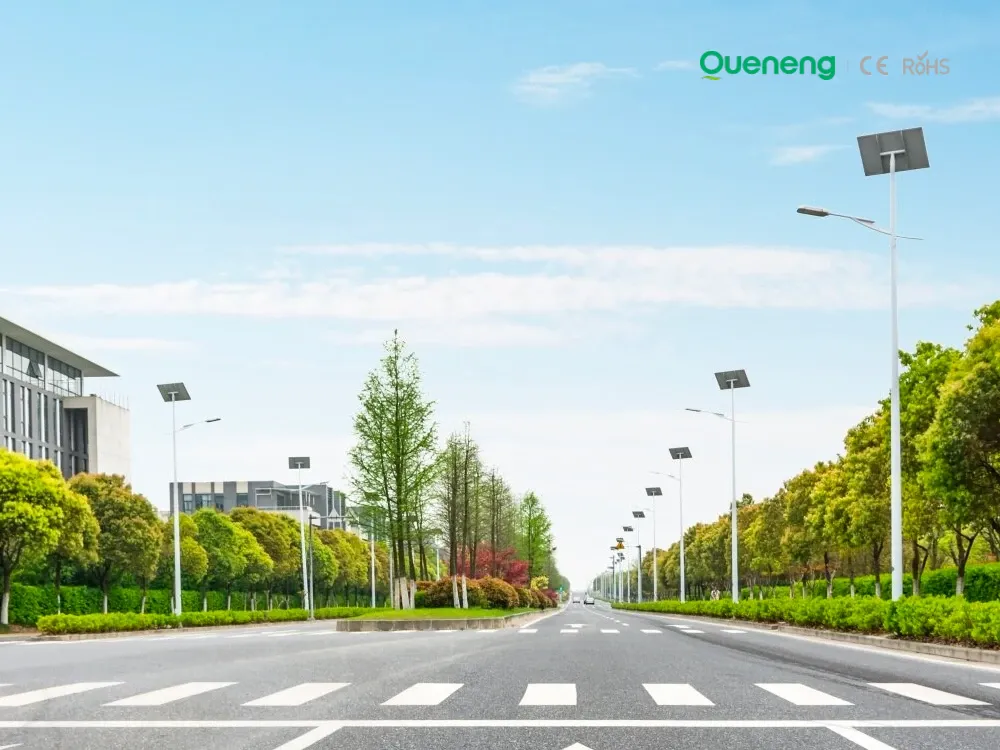
In recent years, the purchase of solar streetlights for municipalities has become a growing trend across the globe. Local governments are under pressure to reduce public expenditure, promote green energy, and create safer communities. Solar streetlights provide a reliable, cost-effective, and sustainable solution that meets these needs. Queneng Lighting, as a leading solar street lighting manufacturer, has supported multiple municipal projects worldwide with customized and energy-efficient solutions.
FAQ
Battery Types and Applications
What is a nanobattery?
Solar Street Light Luzhou
Are Luzhou solar street lights easy to install?
Yes, Luzhou solar street lights are designed for easy installation. They come with all necessary hardware, and installation typically takes just a few hours. The lights do not require any wiring or electrical connections, making them perfect for both residential and commercial applications.
Solar Street Light Luan
What makes Luan solar street lights high-efficiency?
Luan solar street lights are equipped with advanced high-efficiency solar panels and LED technology. The panels capture solar energy effectively, even under low light conditions, while the energy-efficient LEDs provide bright illumination with minimal power consumption, ensuring long-lasting performance.
Solar Street Light Luqing
Do solar street lights work without direct sunlight?
Solar street lights can still operate without direct sunlight as long as the solar panels receive some sunlight during the day to charge the battery. However, performance may be less optimal during prolonged periods of low sunlight, and the battery life may be shorter.
Battery and Analysis
What is the rate of battery discharge? What is the battery's hourly discharge rate?
Distributors
Do I need previous experience in the solar industry to become a distributor?
While previous experience in renewable energy or lighting sectors is beneficial, it is not required. What matters most is your dedication to sustainability, willingness to learn, and ability to effectively serve your local market.


Queneng's Luzhou Solar Street Light provides sustainable, energy-efficient outdoor LED lighting. Powered by solar energy, it's a cost-effective and eco-friendly solution for illuminating streets and pathways. A reliable and durable LED solar street light.

Illuminate your outdoor spaces with the Solar Street Light, a cutting-edge solution combining advanced solar technology and energy-saving LED lighting.

Discover the Lulin High-Performance Solar Street Light by Queneng, a durable and energy-saving outdoor lighting solution. Designed for efficiency and reliability, it harnesses solar power to sustainably illuminate streets and pathways. Optimize your outdoor spaces today with Queneng's innovative solar street lighting technology.

The Solar Streetlights of Luhao for Municipalities are designed to deliver reliable, energy-efficient, and cost-effective public lighting solutions. Equipped with advanced LED technology, durable lithium batteries, and high-efficiency solar panels, these streetlights provide consistent illumination for roads, parks, residential areas, and government projects.

Our professional team is ready to answer any questions and provide personalized support for your project.
You can reach us via phone or email to learn more about Queneng’s solar lighting solutions. We look forward to working with you to promote clean energy solutions!
Rest assured that your privacy is important to us, and all information provided will be handled with the utmost confidentiality.
By clicking 'Send Inquiry Now' I agree to Queneng processing my personal data.
To see how to withdraw your consent, how to control your personal data and how we process it, please see our Privacy Policy and Terms of use.
Schedule a Meeting

Book a date and time that is convenient for you and conduct the session in advance.
Have more questions about our products or services?

